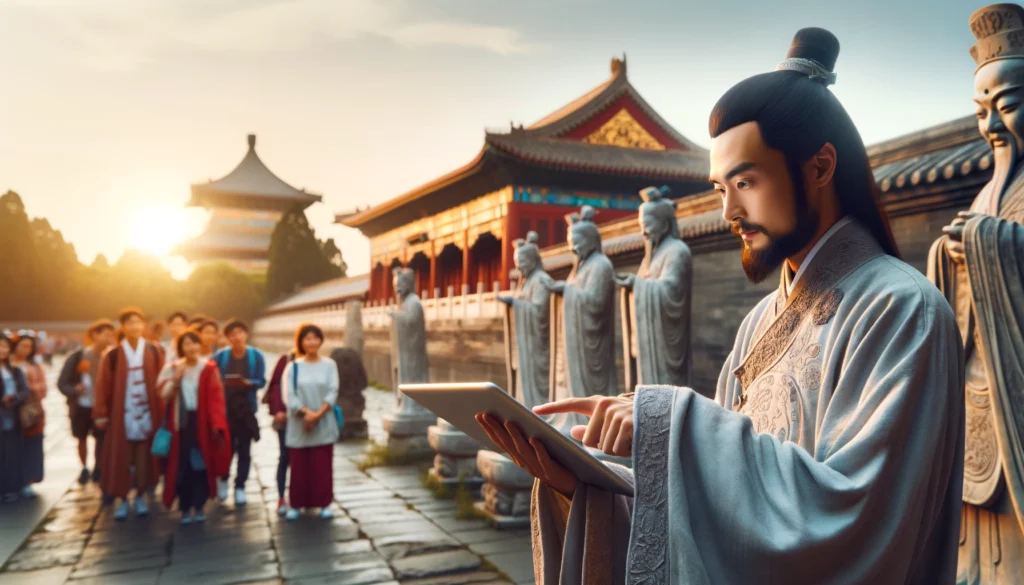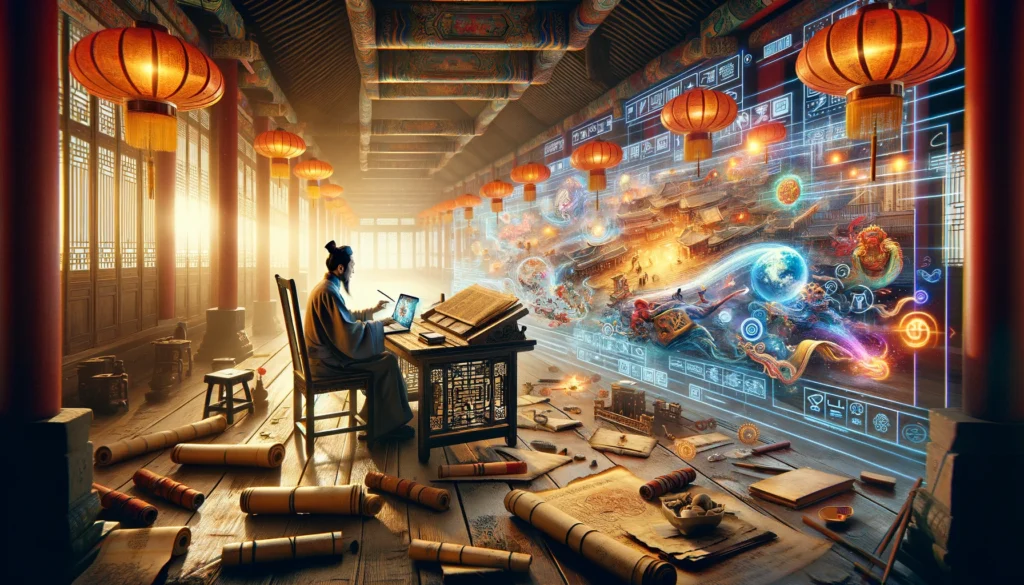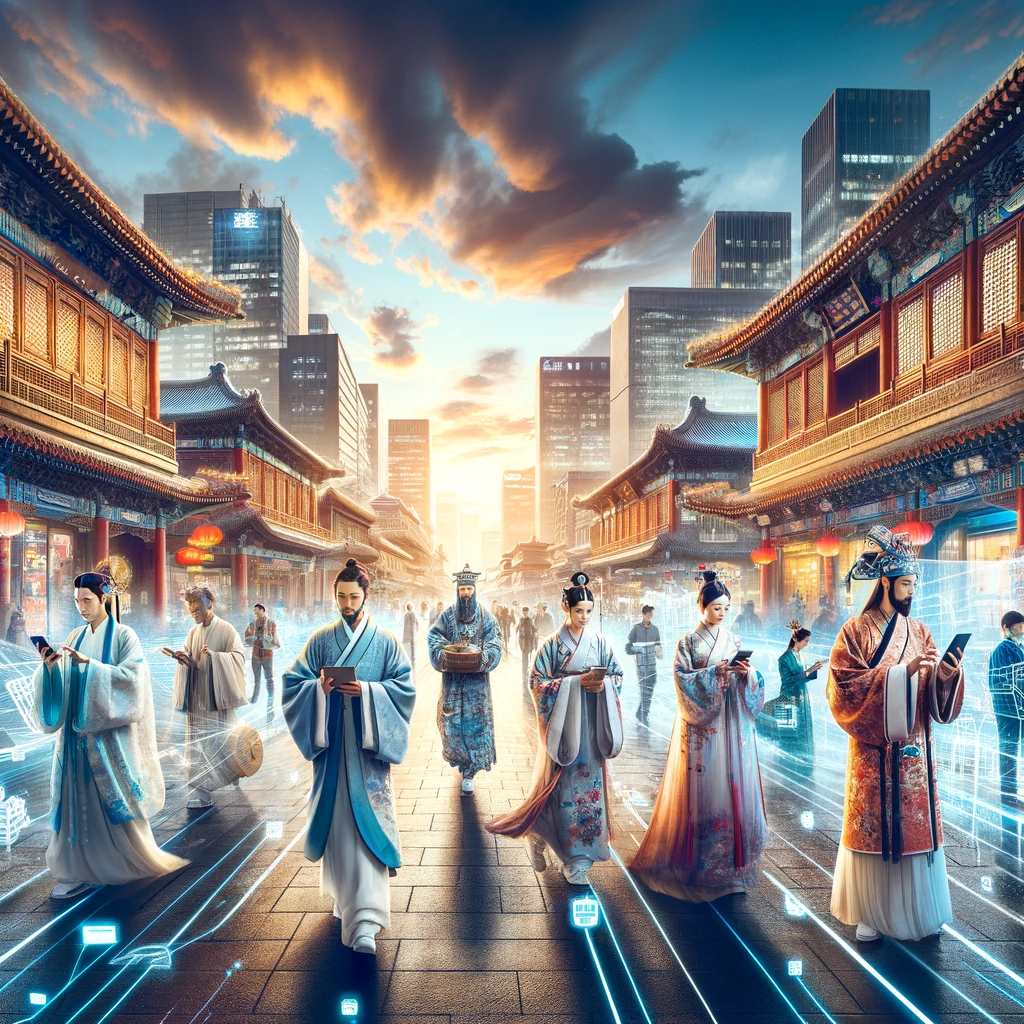In the heart of China’s bustling economic evolution, a wave of new professions emerges, reshaping the workforce landscape and enriching the cultural tapestry. This article delves into the fascinating world of jobs in ancient China, exploring how traditional roles are being revitalized and integrated into the modern economy, offering a unique blend of heritage and innovation.
Key Takeaways
- China’s evolving employment landscape includes 158 new professions that merge cultural heritage with contemporary trends.
- Study tour guides, baristas, and internet marketers are among the professions that exemplify the blend of tradition and modernity in China’s workforce.
- The rise of the creative economy in China underscores the value of cultural education through employment, benefiting both economic growth and cultural preservation.
- Innovative job roles like study tour guides and digital storytellers are pivotal in promoting and preserving China’s rich historical roots.
- The official recognition of new professions in China reflects the country’s forward-thinking approach to adapting its workforce for a dynamic future.
A Tapestry of New Trades: Merging Past and Present

Study Tour Guides: Educators of Heritage
Imagine stepping into the ancient world of China, where every corner holds a story waiting to be told. Now, thanks to the emergence of study tour guides, you don’t just get to visit these places; you get to experience them. In Qufu, Shandong Province, pioneers like Zhu Fen are crafting journeys that weave through the Temple and Cemetery of Confucius, bringing history to life.
These guides are more than just storytellers; they’re cultural ambassadors, bridging the past with the present. Their role is crucial in a country that’s seeing a blend of tradition and modernity, with new professions popping up that pay homage to China’s rich cultural tapestry.
By promoting sustainable tourism, these guides ensure that the wonders they share today will continue to inspire generations to come.
Here’s a glimpse of what they offer:
- Personalized tours that highlight historical significance
- Engaging narratives that connect visitors with ancient traditions
- Educational insights that foster appreciation and preservation
It’s a dual benefit, really. While visitors gain a deeper understanding of China’s heritage, these guides find fulfillment in a career that celebrates their country’s storied past.
Baristas and the Art of Modern Brews

Imagine walking into a bustling cafe in the heart of Beijing, where the aroma of freshly ground coffee beans is as invigorating as the city’s pulse. You’re witnessing a modern twist on an ancient culture, where baristas are becoming as revered as tea masters of old.
In places like Jinan, baristas like Zhang Jing’en are not just making coffee; they’re crafting experiences. Young patrons flock to these modern temples of taste, seeking not just a caffeine fix, but a sip of the evolving Chinese lifestyle. This isn’t just a job; it’s a performance, a blend of tradition and innovation served up in a cup.
With every pour and every brew, these artisans are stirring up more than just coffee—they’re mixing the rich past with an energetic present, creating a new cultural concoction.
Here’s a quick peek at some popular spots and their signature brews:
- JING-A BREWING CO. @ XINGFUCUN BRANCH: Known for the ‘Convex Golden’ beer, a local favorite.
- GREAT LEAP BREWING @ GONGTI BRANCH: Home of the ‘Earthly Spirit Mulberry Sour’, a perfectly balanced sour beer.
- EL NIDO @ XINGFUCUN BRANCH: Don’t miss the ‘Mountain Song Cider’, a sweet hit among cider lovers.
These baristas and brewers are not just serving drinks; they’re ambassadors of a new era, pouring the foundation for a creative economy that’s as robust as the coffee they serve.
Internet Marketers: Weaving Culture into the Web

Imagine you’re scrolling through your feed when you stumble upon a vibrant display of traditional Chinese crafts. This is the handiwork of internet marketers, the digital artisans who blend the rich tapestry of China’s past with the pulsating beat of the modern web. They’re not just selling products; they’re storytelling, crafting narratives that resonate with hearts yearning for a touch of heritage in a digital age.
In the realm of internet marketing, every click and share is a thread in the fabric of cultural renaissance. These marketers are the unsung heroes, the cultural ambassadors who ensure that the essence of ancient China is not lost but reimagined for the global village.
Here’s a glimpse into their toolkit:
- Crafting compelling content that celebrates China’s history
- Utilizing social media platforms to reach a global audience
- Engaging with consumers through interactive campaigns
- Analyzing data to tailor experiences that resonate culturally
As you navigate the web, remember that with every product shared, a story of China’s evolving identity unfolds. It’s a narrative of change, of a nation that honors its roots while branching out into the digital frontier.
The Cultural Renaissance: Jobs that Preserve and Innovate

Reviving Ancient Wisdom: The Role of Study Tour Guides
Imagine stepping into the ancient world of Confucius, where every stone and scripture tells a tale of wisdom. Now, thanks to the likes of Zhu Fen in Qufu, Shandong Province, you don’t just imagine; you experience. Zhu is at the forefront of a new breed of educators, officially recognized in the 2022 edition of China’s occupational list, who are transforming the way we interact with history.
Study tour guides are not just narrators of the past; they are bridges to a living history. They craft journeys that weave together the grand tapestry of China’s cultural heritage with the threads of modern curiosity. Here’s what you can expect from a culture-themed tour:
- Detailed historical context that brings ancient sites to life
- Fascinating stories behind relics and landmarks
- Personalized experiences tailored to your interests
Embracing the role of a study tour guide is more than a job; it’s a commitment to cultural education and appreciation.
Whether you’re a history buff or a first-time visitor, the value of a guide is unmistakable. They don’t just show you around; they unlock the wonder of the past, making the experience deeply personal and infinitely richer. So next time you’re at a historical site, consider the difference a guide could make. It’s not just a tour; it’s a journey through time.
Hanfu Revival: Fashioning the Past into the Present

Imagine stepping into a world where the elegance of ancient dynasties meets the buzz of modern life. That’s the magic of the Hanfu revival. This cultural wave is more than just fashion; it’s a bridge to the past, draped in silk and embroidered with history.
You’ve seen them in pictures, those flowing robes with intricate patterns, and now they’re making a comeback. At places like the Youaiyuncang Hanfu base, you can slip into these traditional garments and for a moment, feel the weight of centuries on your shoulders.
The Hanfu movement isn’t just about the clothes; it’s about embracing an identity and expressing a heritage that’s uniquely Chinese.
Here’s a snapshot of what’s fueling this trend:
- Cultural Pride: A renewed interest in China’s historical identity.
- Fashion Statements: Hanfu as a medium to express individuality.
- Digital Reach: Internet marketers and livestreams making Hanfu accessible worldwide.
And it’s not just about looking the part. The Hanfu movement is creating jobs, from designers to artisans, marketers to event organizers. It’s a whole ecosystem thriving on the blend of old and new. As you don these garments, you’re not just wearing a costume; you’re keeping a story alive, one that continues to unfold and inspire.
Digital Storytellers: Marketing China’s Rich History

Imagine you’re scrolling through your feed when you stumble upon a vibrant tapestry of stories, all unfolding from the screen of your device. Digital storytellers are the new-age narrators, bringing China’s rich history to life through the clicks and swipes of the internet-savvy generation. They’re not just selling a product; they’re selling an experience, an insight into the past that’s as engaging as it is educational.
With every post and livestream, these modern-day scribes are crafting a narrative that’s reshaping perceptions and building bridges between eras.
Here’s how they’re doing it:
- Crafting compelling content that resonates with both young and old.
- Utilizing social media platforms to reach a global audience.
- Merging visual storytelling with interactive elements to enhance engagement.
And let’s not forget the impact they have on the economy. By promoting cultural products and experiences, they’re not just preserving history; they’re also fueling a creative economy that’s as dynamic as the stories they tell.
The Creative Economy: A New Frontier for Employment

The Intersection of Artistry and Commerce
Imagine strolling through a bustling market, where the vibrant tapestry of ancient China’s commerce once unfolded. Today, you’re witnessing a modern renaissance, where art isn’t just a static display in galleries, but a living, breathing part of the economy. Artists and artisans are now entrepreneurs, merging their creative passions with savvy business acumen.
In this new era, the value of art transcends its aesthetic appeal, becoming a cornerstone of cultural identity and economic vitality.
The Silk Road was once a conduit for not just goods, but ideas and culture, linking East and West in a symphony of trade. Now, the spirit of the Silk Road lives on in the digital age, as creators market their crafts to a global audience. Here’s a glimpse into how art and commerce intersect:
- Art Markets: Spaces where creativity meets consumerism, offering unique, handcrafted items.
- Online Platforms: Virtual galleries and shops that break down geographical barriers.
- Cultural Festivals: Events that showcase traditional crafts, attracting tourists and locals alike.
- Collaborative Workshops: Where artists share skills and business insights, fostering a community of growth.
As you navigate this new frontier, remember that every purchase is a vote for the future of art and culture. It’s a way to sustain the livelihoods of those who keep ancient traditions alive while innovating for the future.
Livestreaming Heritage: A Modern Window to Ancient Practices
Imagine you’re scrolling through your feed when you stumble upon a live stream that’s like a portal to the past. You’re suddenly immersed in the vibrant world of ancient China, witnessing the meticulous art of tea-making or the delicate process of silk weaving. Livestreaming isn’t just for influencers and gamers anymore; it’s become a vital tool for cultural custodians to share and sustain China’s rich heritage.
With every stream, these digital storytellers are not just sharing content; they’re breathing life into traditions that might otherwise be forgotten.
Here’s why this trend is catching on:
- It’s interactive, allowing viewers to ask questions and engage with history in real time.
- It provides a platform for artisans to showcase their skills to a global audience.
- Livestreams act as a bridge, connecting the modern world with ancient practices.
Yet, despite the enthusiasm, there’s a shadow looming over this digital renaissance. A recent headline from Bloomberg.com reads, ‘Chinese Live Streaming Is Now on Life Support,’ highlighting the challenges and regulatory hurdles that these cultural broadcasters face. It’s a reminder that while technology can open doors to the past, it also brings with it a set of modern-day obstacles.
Cultural Education Through Employment: A Dual Benefit
Imagine landing a job that not only pays the bills but also deepens your connection to a rich cultural tapestry. In China, this isn’t just a dream—it’s becoming the norm. Employment is no longer just about work; it’s a platform for cultural education.
By stepping into roles that resonate with China’s historical roots, individuals are becoming inadvertent educators and guardians of tradition. This dual benefit enriches both the employee and the community at large.
Here’s how it unfolds:
- Employees gain a deeper understanding of their heritage.
- Communities benefit from the cultural exchange.
- The economy thrives on the unique value of cultural knowledge.
Professor Wang Shuixiong from Renmin University highlights the importance of nurturing talents in these emerging fields. It’s not just about creating jobs; it’s about shaping a workforce that’s adaptable and equipped to carry forward the legacy of a civilization. And let’s face it, who wouldn’t want a job that adds a chapter to the story of their own culture?
From Tradition to Innovation: China’s Employment Evolution

The Official List: A Barometer for Change
Imagine you’re witnessing a society in transformation, where the emergence of new professions signals a shift in cultural and economic tides. The recent expansion of China’s official occupational list by 158 jobs is more than a bureaucratic shuffle; it’s a reflection of this dynamic change. These new roles, from study tour guides to internet marketers, are not just jobs; they’re the bearers of tradition infused with the pulse of modern life.
Here’s a snapshot of how these professions are bridging the past with the present:
- Study tour guides: Ambassadors of history
- Baristas: Crafters of contemporary culture
- Internet marketers: Connectors of heritage and technology
This isn’t just about updating a list; it’s about embracing a future where employment is intertwined with cultural identity. As you navigate through the bustling streets and digital byways of China, you’ll see these new vocations bringing a fresh perspective to time-honored customs.
Cultural Custodians: New Roles in Ancient Settings
Imagine stepping into the shoes of an ancient scholar, or perhaps donning the silk robes of a Ming dynasty artisan. Today’s cultural custodians are doing just that, breathing life into history with their dedication to preserving historical roots while embracing the innovation potential. These roles are more than mere jobs; they’re a bridge connecting the past to the present, allowing us to walk in the footsteps of those who came before us.
- Emperors
- Government officials
- Nobles
- Peasants
- Merchants
- Slaves
Each of these roles played a crucial part in the tapestry of ancient society, and now, new job roles are emerging to honor and educate about this intricate social structure. Think of it as a cultural renaissance through employment, where every artifact tells a story, and every job is an opportunity to keep that story alive.
In this new era, artifacts are not merely relics of the past. They whisper tales of the artisans who crafted them and the hands through which they passed, offering a window into the lives and dreams of those who lived centuries ago.
The Economic Impact of Cultural Employment
Imagine you’re walking through the bustling streets of modern China, where the echoes of ancient dynasties blend with the vibrancy of contemporary life. The economic impact of cultural employment is palpable, as new jobs rooted in tradition breathe life into the economy.
- The Han Dynasty was an age of great economic, technological, cultural, and social progress in China.
- Today, this spirit of innovation continues as cultural custodians become the new economic drivers.
- From study tour guides to digital storytellers, these roles are more than jobs; they’re a bridge connecting the past to the future.
The fusion of cultural reverence and economic vigor is not just about preserving history; it’s about crafting a sustainable future.
As you delve into the world of cultural employment, you’ll find that it’s not just about the number of jobs created. It’s about the quality of these roles and their contribution to a more vibrant and resilient economy. Wang Shuixiong, a sociology professor, highlights the importance of training talents in these new professions, ensuring that the workforce remains adaptable and ready to meet the evolving demands of both the market and society.
Embracing the Past, Shaping the Future
As we wrap up our journey through the dynamic employment landscape of ancient China, it’s evident that the fusion of tradition and innovation has not only enriched the cultural fabric but also carved out new avenues for economic and creative expression. From the emergence of study tour guides to the digital promotion of Hanfu clothing, China’s evolving job market is a testament to its ability to honor its past while boldly stepping into the future. This cultural renaissance, powered by a blend of the old and the new, is not just about adding job titles; it’s about crafting a narrative that weaves together the threads of history with the aspirations of tomorrow. So, as the sun sets on our exploration, let’s carry forward the inspiration drawn from China’s employment evolution—a story of resilience, adaptability, and the timeless pursuit of progress.
Frequently Asked Questions
What new professions in China reflect the blend of tradition and modernity?
New professions such as study tour guides, baristas, and internet marketers reflect the blend of tradition and modernity in China, showcasing the country’s adaptability and innovative approach to employment.
How is China’s cultural heritage being preserved through new jobs?
Jobs like study tour guides, who specialize in culture-themed tours, and internet marketers promoting traditional Hanfu clothing, play a pivotal role in preserving and promoting China’s cultural heritage.
What role do internet marketers play in China’s cultural renaissance?
Internet marketers help bring cultural treasures into the digital age through livestreams and online promotions, making them accessible to a broader audience and driving interest in China’s ancient customs.
How does the emergence of new professions impact China’s economy?
The emergence of new professions contributes to economic growth by creating jobs that blend cultural education with modern trends, stimulating job creation and encouraging a qualitative leap in employment.
What is the significance of the 2022 edition of China’s occupational list?
The 2022 edition of China’s occupational list, which includes professions like study tour guides, signifies the country’s commitment to recognizing and fostering new roles that contribute to cultural preservation and economic innovation.
Can you give an example of how traditional Chinese culture is being adapted for modern audiences?
The Youaiyuncang Hanfu base is an example where tourists can experience traditional Hanfu clothing, and through internet marketing and livestreams, this aspect of Chinese culture is adapted and shared with modern audiences.

